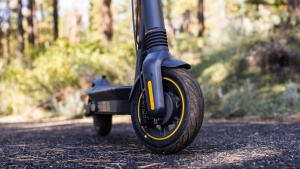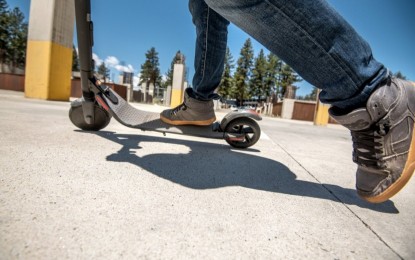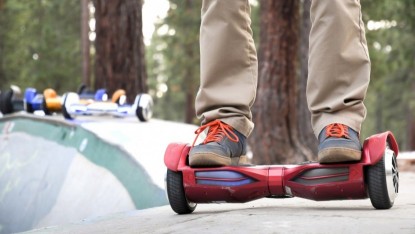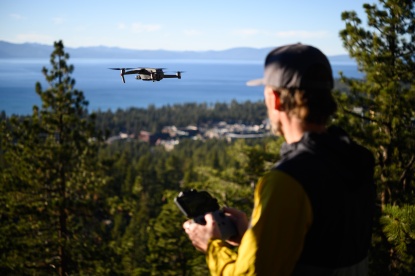In the past five years, our team of experts has bought and tested over 30 scooters. This review compares the best 12 head-to-head across several performance tests. We rode these machines on varying street surfaces and measured hill gradients to appraise their power, ride, braking, and range. Each model endures many speed tests on a flat course to assess the top speed and the experience in each scooter's speed setting. We time how long it takes to charge their batteries and fully assess the ease of portability. After countless hours of pushing each model to its limits, we narrowed the group down to our final recommendations that will satisfy needs ranging from transportation to recreation.
Before you purchase a scooter, please check out our scooter buying advice guide to ensure you get the right one for your needs. If you love zipping around, you may also be interested in some other modes of electric transport, like the best electric skateboards or top hoverboards, which we have also tested extensively.| Awards | |||||
|---|---|---|---|---|---|
| Price | $1,300 List $899.99 at Amazon | $549 List $549.00 at Amazon | $900 List $899.99 at Amazon | $500 List $344.70 at Amazon | $600 List $399.99 at Amazon |
Overall Score  |
|||||
| Star Rating | |||||
| Pros | Good ride comfort, long range, blinkers, cruise control | Lithium-ion battery, measured 22 mile range, 350-watt motor, fast and smooth ride | Powerful, extensive travel range, comfortable | Light-weight, easy to fold, zippy | Decent speed and range, cruise control feature, rear suspension, rear brake light and deck lights, regenerative braking is pretty powerful |
| Cons | Heavy, stiff handlebar latch, app required to travel at full speed | Heavier weight, long charge time | Long recharge time, bulky, heavy, expensive | So-so range, slow to recharge, struggles on steep hills | Solid tires - harsher ride, carrying latch is complicated to work, heavier than average |
| Bottom Line | A best-in-class model that has the power, braking capacity, and comfort to handle long commutes with a trade-off in portability | A smooth driving, high-end electric scooter with an impressive range and a pep in its step | This fully-loaded machine is fast, powerful, and can stop on a dime | This scooter is great for short commutes where carrying the machine is required | A mid-priced scooter for longer distances and avid commuters |
| Rating Categories | Segway Ninebot MAX G2 | Gotrax G4 | Ninebot KickScooter... | Razor E Prime III | Hiboy S2 |
| Range (25%) | |||||
| Power (25%) | |||||
| Ride Comfort (20%) | |||||
| Portability (15%) | |||||
| Braking (15%) | |||||
| Specs | Segway Ninebot MAX G2 | Gotrax G4 | Ninebot KickScooter... | Razor E Prime III | Hiboy S2 |
| Measured Maximum Speed | 21.4 mph | 19.8 mph | 16.7 mph | 18.4 mph | 17 mph |
| Measured Effective Range | 34.4 miles | 22 miles | 25 miles | 8.2 miles | 14 miles |
| Measured Charge Time | 5 hours | 5 hours 50 minutes | 6 hours | 6 hours | 5 hours 40 minutes |
| Brake Type | Front drum brake with a rear electronic brake | Rear disc brake and E-ABS braking system | Front mechanical drum brake. Rear regenerative electric brake. | Front electronic brake and rear fender brake | Front regen Rear disc |
| Tire Type | Pneumatic tubeless and self sealing | Pneumatic | Pneumatic | Pneumatic front Solid rear |
Solid rubber |
| Tire Size | 10" | 10" | 10" | 8" | 8.5" |
| Lights | Yes | Yes | Yes | Yes | Yes |
| Screen | Yes | Yes | Yes | No | Yes |
| App | Yes | No | Yes | No | No |
| Maximum Load | 265 lbs | 220 lbs | 220 lbs | 220 lbs | 220 lbs |
| Bell | Yes, electronic | Yes | Yes | No | Yes |
| Measured Weight | 54 lbs | 37.8 lbs | 43.4 lbs | 24 lbs | 32 lbs |
| Battery Type | Lithium-ion | Lithium | Lithium | Lithium | Lithium |
| Motor | Nominal 450 Watt Max 1000 Watt |
350 Watt | 350 Watt | 250 Watt | 350 Watt |
Best Overall Premium Scooter
Segway Ninebot MAX G2
The Segway Ninebot MAX G2 sets the bar for scooters in our review. It offers impressive top speeds of 21.4 miles per hour and improved hill climbing performance thanks to its powerful 1000W motor. Its substantial range of 34.4 miles makes longer rides possible, while its front and rear suspension ensure a smooth and comfortable ride. City-tuned features like blinkers, deck lights, and Find My iPhone integration make the Max G2 a great commuter scooter. You can also customize certain features in the Segway app to meet your needs.
The Max G2 stands out for its range and speed, but these features will cost you. The scooter clocks in at a hefty 54 pounds, making it challenging to carry around. It does fold down for easier transport, but the latch is stiff and hard to operate. Despite its downsides, the Segway Ninebot Max G2 is an excellent commuter scooter for those who prioritize power, range, and comfort over portability. If you need to haul your scooter up the stairs or store it in a tight space, then consider the Razor E Prime III.
Read more: Segway Ninebot MAX G2
Best Value Scooter
Gotrax G4
The Gotrax G4 is a smooth-riding, long-range electric scooter for those looking to make their commute hassle-free. The lithium-ion battery easily held a charge for almost two hours or 22 miles in our tests, and the large, 10-inch pneumatic wheels help you take on cracks and dips in the pavement with confidence and comfort. The 350-watt powered motor climbs up hills with a steepness grade of 10% (although, naturally, steeper hills reduce speed). With a maximum speed of 20 miles per hour, this zippy transportation device also has reliable brakes.
The G4 is a great all-around scooter, but a powerful motor, durable wheels, and long-lasting batteries add extra weight. At 38 pounds, this scooter is rather cumbersome to carry long distances. With that in mind, we found the weight evenly distributed and the scooter easy to fold up, making popping in and out of your car a breeze. Though the investment is significant, we are thoroughly impressed with how the G4 performed head to head with other models costing hundreds more. If you are searching for a quality-built device that is versatile and reliable enough to ride to work or let your kids ride around the neighborhood, the G4 is an excellent pick. If you are shopping for a lower price point and your desired use doesn't mandate a 22-mile range, then check out the Segway Ninebot E2 Plus.
Read more: Gotrax G4 review
Best on a Tight Budget
Gotrax GXL V2
The Gotrax GXL V2 is a good, do-it-all economy scooter with high-end features. For example, the brakes have an electric anti-locking system for smooth slow-downs, and the accelerator has a cruise-control function to give your thumb a rest on long rides. Additionally, the scooter sports air-filled (pneumatic) tires that provide a smooth ride on rough roads while improving grip in corners. Added frills are a bell, kickstand, and digital display, which provides speed and battery charge information. Finally, the steering column safety latch is quite solid, lending testers confidence to let it rip when out cruising.
The Gotrax GXL V2 has many attractive features, but what it lacks is range and power. During our hill climbing tests, the scooter failed to climb a 10.5% grade hill, which generally separates the lower-end scooters from the higher-end models. Furthermore, the GXL has a max speed of 12 mph and a limited range of only 7.4 miles. Everything considered, this scooter left our adult testers wanting more. Lastly, we had trouble with the carrying latch that secures the steering column in the folded position, enabling it to be used as a carrying handle. Drawbacks aside, the benefits of the scooter and the low price make it a good option for smaller riders primarily using it for short commutes and recreation. Those with a hilly commute should look for a higher-powered scooter like the Segway Ninebot Max G2.
Read more: Gotrax GXL V2 review
Best for Portability
Razor E Prime III
The Razor E Prime III is the ticket when portability is critical. It weighs significantly less than most other models in this review and is relatively easy to carry. For being so light, it has a surprisingly high top speed and is nimble, making it fun to carve and turn.
We found the Razor impressive. But like all the other models, this scooter isn't perfect. For instance, the range is half that of many other models. It is also not particularly powerful at climbing hills. Still, the Razor is a great commuter option and may have all the range and power you need for your daily life. Those who desire a more comfortable ride should consider models with pneumatic tires like the Gotrax G4.
Read more: Razor E Prime III review
Compare Products
Why You Should Trust Us
To find out which electric scooters are the best in class, we did an exhaustive investigation of all the top brands and models. Based on this research, we bought all the models that showed promise to perform at a high level. We ran each through a battery of comparative testing that pushed the machines to the limits of their performance, utility, and handling. These analyses include (but are not limited to) speed, hill-climbing ability, braking, battery longevity and recharge speed, and portability. Our goal here is to simulate the highest demands a consumer could place on these machines and evaluate which could stand up to such impositions.
Our testing for electric scooters is comprised of five rating metrics:- Range (25% of overall score weighting)
- Power (25% weighting)
- Ride Comfort (20% weighting)
- Portability (15% weighting)
- Braking (15% weighting)
Senior Research Analyst Austin Palmer, Senior Review Editor Nick Miley, and Review Editor Isaac Laredo have more than 22 years of combined experience in consumer product analyses and reviews. Austin has extensive experience testing and reviewing personal transportation devices such as hub motor and belt-driven electric skateboards, monowheels, hoverboards, and self-balancing scooters, as well as myriad other electronic devices. Additionally, Nick has spent years in university laboratories posing research questions, designing experiments, refining protocols, and writing about the results. Isaac's background engaging in the scientific process and years of experience as a product reviewer rounds out the team's skill set.
Analysis and Test Results
To analyze the practical strengths and weaknesses of scooters, we devised quantifiable tests to allow us to rate each product side by side. An analysis of this sort prevents us from making vague, anecdotal assertions. Instead, we hone in on specific metrics of interest, such as scooter portability, battery range, ride, braking, and power. The following sections delve into each test metric and explain how we quantify the performance of each product. Read on to find the right electric scooter for you.
Value
When purchasing an electric scooter, you first need to consider how the scooter will primarily be used. Generally speaking, the more you ask from these vehicles, the more you will have to fork over at checkout. However, this does not equate to a reduction in value so long as the functionality increases with the price. Let's say you want a commuter scooter, and your particular commute is 5 miles each way, and the route has a few short, steep hills. When you reach your destination, you must fold the scooter up to ride the elevator to your office. And let's suppose it's not possible to recharge the battery for the return trip.
This kind of commute demands a scooter like the Ninebot Max or Gotrax G4, with the Gotrax being the better value for most riders. Both of these products, though, require a considerable outlay of cash. However, we would say that they offer a high value because they can meet all of the requirements above, whereas a less expensive product would leave you walking up the hills or running out of battery. Conversely, if one is looking for a fun toy for the kids to play with in the driveway, the high-end scooters would be overkill. For the best intersection of performance and price, the Gotrax GXL V2 fits in well. It can handle shorter commutes as well as youthful romps, and its price tag is less daunting than the premium models. You will sacrifice some power, range, and portability at this lower price point, but it's one of the smoothest riding machines we tested, and it has a great brake system as well, adding an extra measure of safety. Another model that strikes this difficult balance is the Segway E2 Plus; its lighter weight and reliable carrying system is complemented by a range of 10.9 miles and a top speed of nearly 15 mph. The build quality and features, such as deck lighting and the Segway app, enhance the value of this model.
Range
Range, or travel radius, is the distance you can travel on a single battery charge, and it should be the first factor to consider when shopping for an electric scooter because all the other considerations fall by the wayside if your ride runs out of juice and you end up walking. Most manufacturers provide a claimed range that typically involves ideal conditions and a slower speed (less power consumption). To collect comparable range data on the models, we first set up a flat test track of known length on surface streets near our lab. We then ran the contending models around the course at 13 mph (or at their top speed if lower) until the batteries drained to the point that they could no longer propel the scooter and rider.
A scooter's range may be more or less important to you depending on your intended use, of course, so it is important to consider how and how far you plan on riding it. If you have a long commute, you will want to be sure to get a scooter that can actually make it there. If the scooter is just for your kids to play in the neighborhood, a shorter range may be just fine.
This test highlights some nuanced issues requiring the establishment of two subcategories to quantify and accurately explain each model's range. These are effective range and maximum range. We define the effective range as the number of miles traversed at or near the scooter's maximum speed. Conversely, we define the maximum range as the longest distance you can travel at any speed. Ideally, one would want the battery to propel the scooter and rider at full tilt until the very end of the battery's charge. However, this is not the case with a number of the models tested. The Gotrax G4 happily strutted along for about 22 miles, and the Ninebot Max impressed us with 25 miles. The clear winner in the range test was the Ninebot Max G2 at 34.4 effective miles.
Complementing the range analysis is the charge time. All the models in this review, except for the Razor E300, use lithium-ion batteries. The average charging time for these batteries is about 4.7 hours. While charge times vary a great deal, one way to look at a model's performance is as a ratio of charge time to range. Using this as a yardstick, the Ninebot Max G2 is a standout with a recharge time of 5 hours and a range of 34.4 miles. That's just 8 minutes and 50 seconds of charge time per mile traveled.
Power
We concede that power is a fairly general term, but it's nonetheless an important performance consideration for any motor-powered vehicle test. We break this metric into an assessment of a vehicle's maximum speed and its ability to climb both moderate (3.5%) and steep (10.5%) grades. The speed test, which was conducted on flat ground, is simply an assessment of maximum speed in miles per hour.
Before we dive into the power tests, we should first mention how these scooters get going. Most of the test models will not take off from a dead stop without the rider first kicking once to get them moving. Once the machine gets some human-powered momentum, the electric motor takes over. It pays the human back in kind, plus some serious interest as it accelerates and cruises without any additional input.
On to the speed tests: we took each scooter three separate times up to its maximum flat ground speed — the speed with the throttle fully depressed — and timed it while it traversed a 100-foot stretch. The Ninebot Max (16.7 mph), Hiboy S2 (17 mph), Razor E Prime III (18.4 mph), and Gotrax G4 (19.8 mph) are standouts in this category for their top speeds, but our true winner is the Segway Max G2. The Max G2 hits a whopping 21.4 miles per hour, easily besting the others in this test. This result didn't come as too much of a surprise, given the model's 1000W motor.
As for hill climbing capability, most of the models in our test suite cruised up the 3.5% grade with mild reductions in speed ranging from 3-7 mph. When forced to ascend the much steeper (10.5% grade) quarter-mile test slope, most scooters displayed their lack of power and failed to complete the ascent. The Ninebot MAX flew up this hill like it had a hellhound chasing its rear wheel. No other model matched this scooter's uphill power and speed, but its successor, the Max G2, was its closest competitor. It was unfazed by the 3.5% slope and only slowed to a respectable 10 mph on the steeper 10.5% grade. The Gotrax G4 wasn't far behind. It only lost a few miles per hour on the 3.5% grade and crawled up the 10.5% grade at a slow 5-6 miles per hour.
Ride Comfort
An electric scooter's ride is a more subjective metric than the others discussed thus far. However, it is a critical aspect of our appraisal because it evaluates the smoothness — or lack thereof — that any person who has operated a vehicle knows. To make this assessment as objective as possible, we test each model on the same 1.2-mile surface street loop with various surface textures. When the scooter wheels pass over bumps and cracks in the road, we ask ourselves: how aware are we of these features? When on rough surfaces that cause vibration, we asked: how do our hands and feet feel? Is there any discomfort? Do we feel in control? And most importantly, is this still fun?
One way to contextualize the questions posed above is to create a spectrum for comparison that has a skateboard (small, hard rubber wheels) on one end and a beach cruiser bike (large pneumatic or air-filled tires) on the other. As the reader may already know, skateboards give a ton of feedback passing over cracks. In comparison, pneumatic (air-filled) tires on a bike provide some give and, thus, absorb vibration quite well.
Of the highest-rated model in the ride metric, the Max G2 was head and shoulders above the rest. It features 10" pneumatic tires along with front and rear suspension to provide a supremely smooth ride.
Other products in this review that enjoy high marks in the ride metric — such as the Gotrax G4, Gotrax GXL V2, and Ninebot MAX — also have pneumatic tires. Accordingly, they transfer minimal vibration through the handlebars and the deck (standing platform). The E2 Plus and Superfun S1-A find a balance between the two tire types with a maintenance-free hybrid tire. It uses rubber structures resembling vertical beams to support the tire's walls. This tire provides the durability of a solid tire without the correlated sacrifice to the ride comfort. While not as comfortable as pneumatic tires, they are an overall improvement. On the other hand, the models with hard tires, such as the Unagi Model One and Hiboy S2, offer a relatively rough ride. Even the Segway Ninebot ES, which has solid tires and a front and rear suspension system, does not achieve equivalent ride quality to the models with pneumatic tires.
The ride isn't just a luxury. A rough riding product can be a safety concern because roughness at its extreme translates to a loss of stability and, ultimately, control. On the other hand, a smooth ride provides a predictable platform that allows the operator to focus on other concerns, such as cars, pedestrians, and potholes, that have the potential to give more serious feedback.
Braking
Up to this point, we have concerned ourselves with the movement of the scooters: how fast, how far, and how smooth. To be sure, these are important features to consider. However, stopping is pretty important. Before going into how we assess braking, let's first look at the different types of brakes employed by the scooters in our review. These are electronic, disk, fender, and drum. The first is a battery-dependent magnetic device, while the latter are friction devices.
In most cases, the brakes discussed above will be paired either as disk and motor or fender and motor. In the case of the Ninebot MAX, it's a drum and motor. The Razor E300 is an exception as it only employs a single brake.
Our top performers in this category are the Gotrax GXL V2, G2 MAX, Ninebot E2 Plus, Ninebot KickScooter MAX and the Unagi Model One. Other notable performers in the braking metric were the Hiboy S2 and the Ninebot KickScooter ES2.
The way we see it, there are two scenarios in which brake performance is critical. The first is flat-ground braking when something unexpected occurs, and you must bring the scooter to a rapid halt. An example would be when you're cruising down the street, and a car unexpectedly pulls out in front of you. The other is when you're heading down a hill. Although zipping around at high speeds can be a hoot, hills are where things can quickly get out of hand, so you need to be able to rein it in quickly.
We dubbed our hill test the confidence on descent test. We conducted these tests on three different grades (5, 10, and 15%). All the models performed well on the shallower two grades, so we'll discuss the steepest of the three. Each model we tested allowed us to hold their speed to a comfortable level or come to a complete stop on a 15% grade. However, we discovered that if we carried speed into the hill, this outcome became a bit harder to achieve, requiring additional brake pressure and resulting in prolonged slowdown distances.
Models with fender brakes proved a bit more difficult to use on the steeps due to the required change in foot position and weight distribution. Models with dual brake systems activated by a single-hand lever proved most effective on descents because the system is quite powerful. Moreover, the convenience of the hand lever allowed the test rider to maintain a balanced, comfortable position that was otherwise disrupted when using a fender brake.
The flat ground stop tests uncovered some unanticipated disparities in the braking systems when contrasted with the descent tests. First, we were surprised by the distances required to bring a scooter going ~12 mph to a complete stop using the motor + disk brake system. Second, we were surprised and impressed by the power produced by the fender brake. On average, the motor + disk systems took 27.9 feet, while the fender brakes took 16.3 to stop completely. The Gotrax GXL V2 reduced that distance to just 12 feet, the shortest in the class.
Portability
Portability is a critical feature for anyone who wants to use a scooter as a transportation device in an urban setting. Why? Well, the machine must be able to fold to stow in an apartment, office, on a train, or in the trunk of a car. Additionally, the machine must be light enough to carry up a flight of stairs or through turnstiles. With a critical eye on design features supporting these needs, we looked at the folded dimensions (compactness), the carrying handle, and the ability to roll the machine — opposed to carrying it — when folded.
The Ninebot MAX, Max G2, and Razor E300 are outliers in this metric as they each weigh over 40 pounds and have bulky dimensions relative to others in the class. However, all of the products in this review except the Razor E300 attempt to address the portability issue.
The Razor E Prime III is by far the lightest model in our review and the only model we really would recommend carrying for longer distances when commuting. Trailing the Razor, the Gotrax G4, E2 Plus and Unagi Model One aren't far behind.
Conclusion
There are dozens of electric scooters on the market today, and each year the number grows. We know how difficult it can be to pick one out of the many and still feel confident about the decision. Above, we have outlined what we think are the most important factors to consider and which models perform best in each area. We hope that this thorough review will aid you in purchasing one of these fun and practical machines.
— Nick Miley and Austin Palmer

































